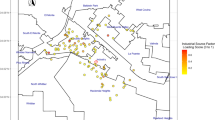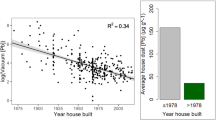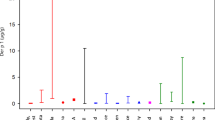Abstract
Children living near hazardous waste sites may be exposed to environmental contaminants, yet few studies have conducted multi-media exposure assessments, including residential environments where children spend most of their time. We sampled yard soil, house dust, and particulate matter with aerodynamic diameter <2.5 in 59 homes of young children near an abandoned mining area and analyzed samples for lead (Pb), zinc (Zn), cadmium (Cd), arsenic (As), and manganese (Mn). In over half of the homes, dust concentrations of Pb, Zn, Cd, and As were higher than those in soil. Proximity to mine waste (chat) piles and the presence of chat in the driveway significantly predicted dust metals levels. Homes with both chat sources had Pb, Zn, Cd, and As dust levels two to three times higher than homes with no known chat sources after controlling for other sources. In contrast, Mn concentrations in dust were consistently lower than in soil and were not associated with chat sources. Mn dust concentrations were predicted by soil concentrations and occupant density. These findings suggest that nearby outdoor sources of metal contaminants from mine waste may migrate indoors. Populations farther away from the mining site may also be exposed if secondary uses of chat are in close proximity to the home.
This is a preview of subscription content, access via your institution
Access options
Subscribe to this journal
Receive 6 print issues and online access
$259.00 per year
only $43.17 per issue
Buy this article
- Purchase on Springer Link
- Instant access to full article PDF
Prices may be subject to local taxes which are calculated during checkout


Similar content being viewed by others
References
Adachi K., and Tainosho Y. Characterization of heavy metal particles embedded in tire dust. Environ Int 2004: 30 (8): 1009–1017.
Agency for Toxic Substances and Disease Registry (ATSDR). Tar Creek Superfund Site: Report to Congress. US Department of Health and Human Services, Public Health Service, Atlanta, GA, 2004.
Agency for Toxic Substances and Disease Registry (ATSDR). 2005 CERCLA Priority List of Hazardous Substances. US Department of Health and Human Services, Public Health Service, Atlanta, GA, 2005.
Agency for Toxic Substances and Disease Registry (ATSDR). Toxicological Profile for Manganese (Draft for Public Comment). US Department of Health and Human Services, Public Health Service, Atlanta, GA, 2008.
Baxter L.K., Clougherty J.E., Laden F., and Levy J.I. Predictors of concentrations of nitrogen dioxide, fine particulate matter, and particle constituents inside of lower socioeconomic status urban homes. J Expo Sci Environ Epidemiol 2007: 17 (5): 433–444.
Bellinger D.C., Stiles K.M., and Needleman H.L. Low-level lead exposure, intelligence and academic achievement: a long-term follow-up study. Pediatrics 1992: 90 (6): 855–861.
Bondy S.C., and Campbell A. Developmental neurotoxicology. J Neurosci Res 2005: 81 (5): 605–612.
Bradman A., and Whyatt R.M. Characterizing exposures to nonpersistent pesticides during pregnancy and early childhood in the National Children's Study: a review of monitoring and measurement methodologies. Environ Health Perspect 2005: 113 (8): 1092–1099.
Chew G.L., Burge H.A., Dockery D.W., Muilenberg M.L., Weiss S.T., and Gold D.R. Limitations of a home characteristics questionnaire as a predictor of indoor allergen levels. Am J Respir Crit Care Med 1998: 157 (5): 1536–1541.
Clark H.F., Hausladen D.M., and Brabander D.J. Urban gardens: lead exposure, recontamination mechanisms, and implications for remediation design. Environ Res 2008: 107 (3): 312–319.
Clausnitzer H., and Singer M.J. Environmental influences on respirable dust production from agricultural operations in California. Atmos Environ 2000: 34 (11): 1739–1745.
Clayton C.A., Pellizzari E.D., Whitmore R.W., Perritt R.L., and Quackenboss J.J. National Human Exposure Assessment Survey (NHEXAS): distributions and associations of lead, arsenic and volatile organic compounds in EPA region 5. J Expo Anal Environ Epidemiol 1999: 9 (5): 381–392.
Cohen Hubal E.A., Sheldon L.S., Burke J.M., McCurdy T.R., Berry M.R., and Rigas M.L., et al. Children's exposure assessment: a review of factors influencing children's exposure, and the data available to characterize and assess that exposure. Environ Health Perspect 2000: 108 (6): 475–486.
Ettinger A.S., Zota A.R., Amarasiriwardena C.J., Hopkins M.R., Schwartz J., and Hu H., et al. Maternal arsenic exposure and impaired glucose tolerance during pregnancy. Environ Health Perspect 2009: 117 (7): 1059–1064.
Fergusson J.E., and Kim N.D. Trace-elements in street and house dusts—sources and speciation. Sci Total Environ 1991: 100: 125–150.
Hogervorst J., Plusquin M., Vangronsveld J., Nawrot T., Cuypers A., and Van Hecke E., et al. House dust as possible route of environmental exposure to cadmium and lead in the adult general population. Environ Res 2007: 103 (1): 30–37.
Hu H., Shine J., and Wright R.O. The challenge posed to children's health by mixtures of toxic waste: the tar creek superfund site as a case-study. Pediatr Clin North Am 2007: 54 (1): 155–175.
Lanphear B.P., Hornung R., Khoury J., Yolton K., Baghurst P., and Bellinger D.C., et al. Low-level environmental lead exposure and children's intellectual function: an international pooled analysis. Environ Health Perspect 2005: 113 (7): 894–899.
Long C.M., Suh H.H., Catalano P.J., and Koutrakis P. Using time- and size-resolved particulate data to quantify indoor penetration and deposition behavior. Environ Sci Technol 2001: 35 (10): 2089–2099.
Malcoe L.H., Lynch R.A., Kegler M.C., and Skaggs V.J. Lead sources, behaviors, and socioeconomic factors in relation to blood lead of native American and white children: a community-based assessment of a former mining area. Environ Health Perspect 2002: 110 (Suppl 2): 221–231.
Marple V.A., Rubow K.L., Turner W., and Spengler J.D. Low flow-rate sharp cut impactors for indoor air sampling—design and calibration. JAPCA 1987: 37 (11): 1303–1307.
Meyer I., Heinrich J., and Lippold U. Factors affecting lead, cadmium, and arsenic levels in house dust in a smelter town in eastern Germany. Environ Res 1999: 81 (1): 32–44.
National Research Council. Environmental Epidemiology: Public Health and Hazardous Wastes. National Academy Press, Washington, DC, 1991.
Needleman H.L., Schell A., Bellinger D., Leviton A., and Allred E.N. The long-term effects of exposure to low doses of lead in childhood. An 11-year follow-up report. N Engl J Med 1990: 322 (2): 83–88.
O’Rourke M.K., Van de Water P.K., Jin S., Rogan S.P., Weiss A.D., and Gordon S.M., et al. Evaluations of primary metals from NHEXAS Arizona: distributions and preliminary exposures. National Human Exposure Assessment Survey. J Expo Anal Environ Epidemiol 1999: 9 (5): 435–445.
Oklahoma Office of the Secretary of Environment. Governor Frank Keating's Tar Creek Superfund Task Force Final Report, 2000.
Perry P.M., Pavlik J.W., Sheets R.W., and Biagioni R.N. Lead, cadmium, and zinc concentrations in plaster and mortar from structures in Jasper and Newton Counties, Missouri (Tri-State Mining District). Sci Total Environ 2005: 336 (1–3): 275–281.
Riederer A.M., Shine J.P., Danan L.M., and Ford T.E. Concentrations of lead and mercury in multimedia samples from homes near the former Clark Air Base, Philippines. Sci Total Environ 2005: 341 (1–3): 53–69.
Rollin H., Mathee A., Levin J., Theodorou P., and Wewers F. Blood manganese concentrations among first-grade schoolchildren in two South African cities. Environ Res 2005: 97 (1): 93–99.
Schaider L.A., Senn D.B., Brabander D.J., McCarthy K.D., and Shine J.P. Characterization of zinc, lead, and cadmium in mine waste: implications for transport, exposure, and bioavailability. Environ Sci Technol 2007: 41 (11): 4164–4171.
Shine J.P., Ika R.V., and Ford T.E. Multivariate statistical examination of spatial and temporal patterns of heavy metal contamination in New Bedford harbor marine sediments. Environ Sci Technol 1995: 29 (7): 1781–1788.
Smith K.S., and Huyck H.L.O. An overview of the abundance, relative mobility, bioavailability, and human toxicity to metals. In: Plumlee G.S. and Lodgsdon M. (eds). The Environmental Geochemistry of Mineral Deposits, Part A: Processes, Techniques, and Health Issues, vol. Reviews in Economic Geology, v. 6A. Society of Economic Geologists, Littleton, CO, 1999, pp 29–70.
Takser L., Lafond J., Bouchard M., St-Amour G., and Mergler D. Manganese levels during pregnancy and at birth: relation to environmental factors and smoking in a Southwest Quebec population. Environ Res 2004: 95 (2): 119–125.
The Interstate Technology & Regulatory Council. Mine Waste Issues in the United States: A White Paper. Interstate Technology & Regulatory Council, Mining Waste Team, Washington, DC, 2008.
Tian L.L., Zhao Y.C., Wang X.C., Gu J.L., Sun Z.J., and Zhang Y.L., et al. Effects of gestational cadmium exposure on pregnancy outcome and development in the offspring at age 4.5 years. Biol Trace Elem Res 2009: 132 (1–3): 51–59.
US EPA. Residential Sampling for Lead: Protocols for Dust and Soil Sampling. US Environmental Protection Agency, Washington, DC, 1995.
US EPA. Child-Specific Exposure Factors Handbook (Final Report). US Environmental Protection Agency, Washington, DC, 2008.
US EPA. Tar Creek (Ottawa County). Oklahoma Update. http://www.epa.gov/region6/6sf/pdffiles/0601269.pdf, 2010. Accessed 5 August 2010.
Weiss B. Vulnerability of children and the developing brain to neurotoxic hazards. Environ Health Perspect 2000: 108 (Suppl 3): 375–381.
Wright R.O., Amarasiriwardena C., Woolf A.D., Jim R., and Bellinger D.C. Neuropsychological correlates of hair arsenic, manganese, and cadmium levels in school-age children residing near a hazardous waste site. Neurotoxicology 2006: 27 (2): 210–216.
Zota A.R., Ettinger A.S., Bouchard M., Amarasiriwardena C.J., Schwartz J., and Hu H., et al. Maternal blood manganese levels and infant birth weight. Epidemiology 2009a: 20 (3): 367–373.
Zota A.R., Willis R., Jim R., Norris G.A., Shine J.P., and Duvall R.M., et al. Impact of mine waste on airborne respirable particulates in Northeastern Oklahoma, United States. J Air Waste Manage Assoc 2009b: 59 (11): 1347–1357.
Acknowledgements
This study was supported by the National Institute of Environmental Health Sciences (NIEHS) Superfund Basic Research Program Grant P42-ES016454; NIEHS Center Grant 2 P30-ES 00002; NIEHS K23 ES000381; NIEHS Children's Center Grant 1 P01-ES012874; and US EPA STAR Research Assistance Agreement No. RD-83172501. We acknowledge the active involvement and continued cooperation of our community partners: Local Environmental Action Demanded (L.E.A.D.) Agency and Integris Baptist Regional Health Center, Miami, OK, USA. We are grateful to the families who participated in this study. We thank Mary Happy, Karen Fields, Debbie Glassman, Vickie Kelly, Rebecca Lincoln, Kathleen McCarthy, and Adam Schmidt for assistance in field sampling; and Kimberly Newton, Dan Brabander, MeiAi Khoo, Emily Knurek, Robert Willis, and Nick Lupoli for assistance with sample analysis. We also thank Drs Joel Schwartz and Howard Hu for their input on the development of this study and analysis of the data.
Author information
Authors and Affiliations
Corresponding author
Ethics declarations
Competing interests
The authors declare no conflict of interest.
Rights and permissions
About this article
Cite this article
Zota, A., Schaider, L., Ettinger, A. et al. Metal sources and exposures in the homes of young children living near a mining-impacted Superfund site. J Expo Sci Environ Epidemiol 21, 495–505 (2011). https://doi.org/10.1038/jes.2011.21
Received:
Accepted:
Published:
Issue Date:
DOI: https://doi.org/10.1038/jes.2011.21
Keywords
This article is cited by
-
Identification of Legacy and Active Sources of Metal Contamination in Soils in Brooklyn, NY
Archives of Environmental Contamination and Toxicology (2022)
-
The presence of Superfund sites as a determinant of life expectancy in the United States
Nature Communications (2021)
-
Assessing Children’s Lead Exposure in an Active Mining Community Using the Integrated Exposure Uptake Biokinetic Model
Exposure and Health (2021)
-
Health risk assessment of heavy metals exposure via consumption of crops grown in phosphogypsum-contaminated soils
Environmental Geochemistry and Health (2021)
-
Opportunities for evaluating chemical exposures and child health in the United States: the Environmental influences on Child Health Outcomes (ECHO) Program
Journal of Exposure Science & Environmental Epidemiology (2020)



